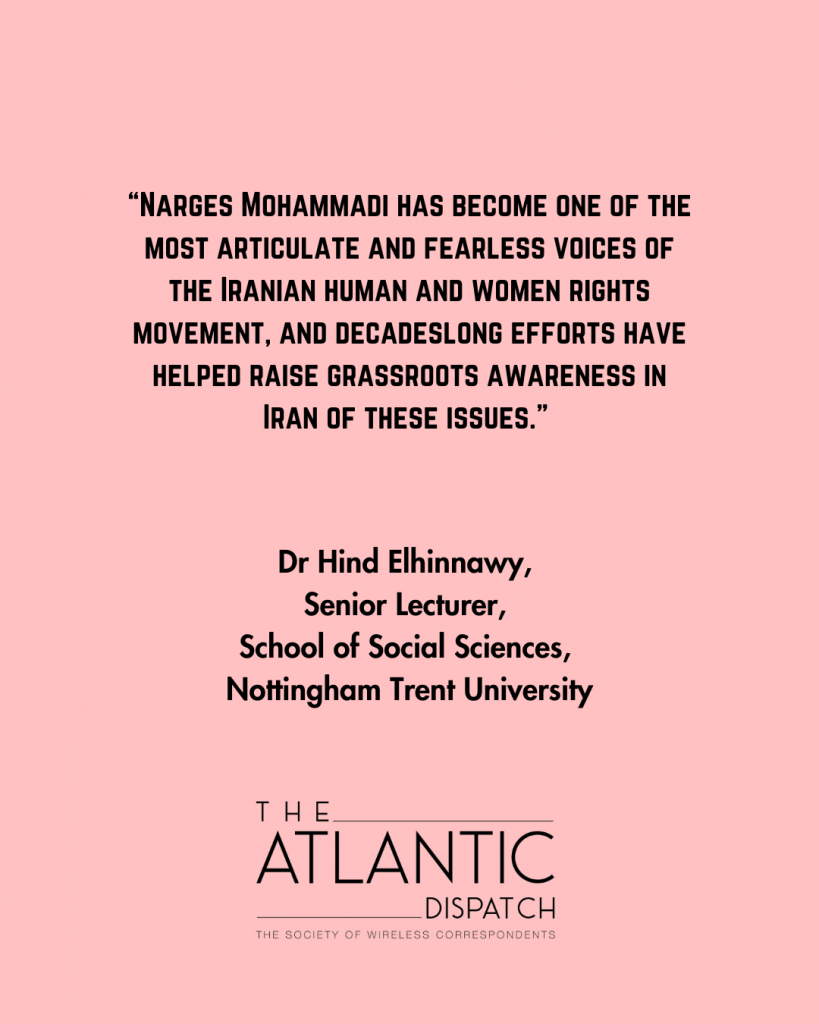This month it was announced that The Norwegian Nobel Committee had decided to award the Nobel Peace Prize for 2023 to Narges Mohammadi for her fight against the oppression of women in Iran and her fight to promote human rights and freedom for all.
Her brave struggle has come with tremendous personal costs. Altogether, the regime has arrested her 13 times, convicted her five times, and sentenced her to a total of 31 years in prison and 154 lashes. As I write this, Narges Mohammadi is still in prison.
WOMEN LIFE FREEDOM
In September 2022 a young Kurdish woman, Mahsa Jina Amini, was killed while in the custody of the Iranian morality police. Her killing triggered the largest political demonstrations against Iran’s theocratic regime since it came to power in 1979. Under the slogan “Woman – Life – Freedom”, hundreds of thousands of Iranians took part in peaceful protests against the authorities’ brutality and oppression of women.
The regime cracked down hard on the protests: more than 500 demonstrators were killed. Thousands were injured, including many who were blinded by rubber bullets fired by the police. At least 20,000 people were arrested and held in regime custody.
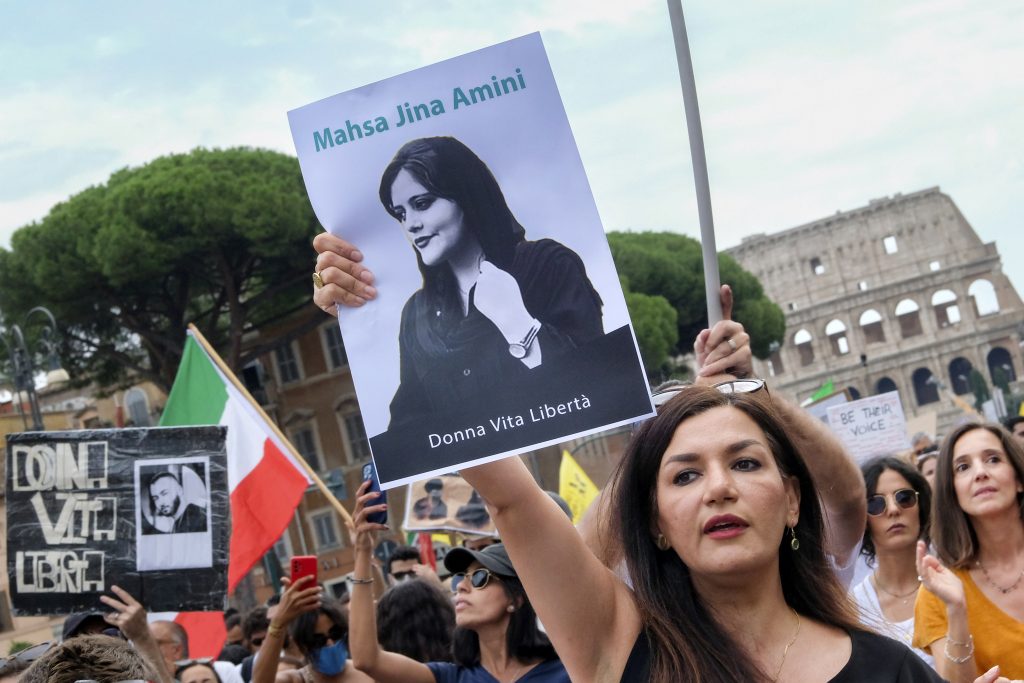
The motto adopted by the demonstrators – “Woman – Life – Freedom” – suitably expresses the dedication and work of Narges Mohammadi.
Woman. She fights for women against systematic discrimination and oppression.
Life. She supports women’s struggle for the right to live full and dignified lives. This struggle across Iran has been met with persecution, imprisonment, torture and even death.
Freedom. She fights for freedom of expression and the right to independence and against rules requiring women to remain out of sight and to cover their bodies. The freedom demands expressed by demonstrators apply not only to women but to the entire population.
“The more of us they lock up, the stronger we become.”
In the 1990s, as a young physics student, Narges Mohammadi was already distinguishing herself as an advocate for equality and women’s rights. After concluding her studies, she worked as an engineer as well as a columnist in various reform-minded newspapers. In 2003 she became involved with the Defenders of Human Rights Center in Tehran, an organisation founded by Nobel Peace Prize laureate Shirin Ebadi. In 2011 Narges Mohammadi was arrested for the first time and sentenced to prison for her efforts to assist incarcerated activists and their families.
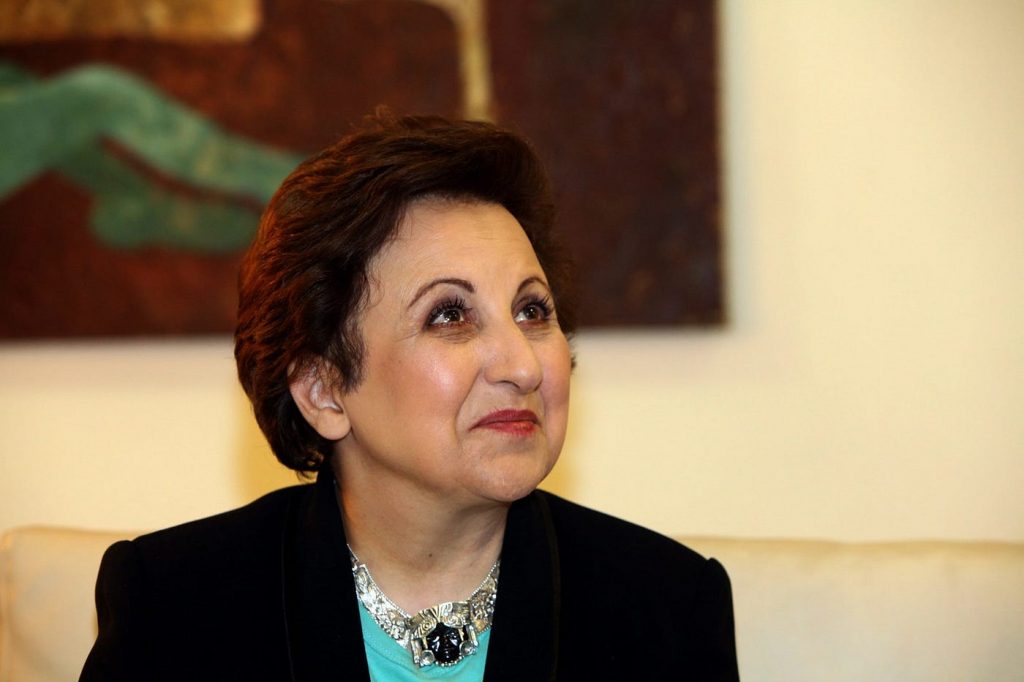
Two years later, after her release on bail, Narges immersed herself in a campaign against the use of the death penalty. Iran has long been among the countries that execute the highest proportion of their inhabitants annually. Since January 2022, more than 860 prisoners have been punished by death in Iran.
Her activism against the death penalty led to her re-arrest in 2015 and to a sentence of additional years behind walls. Upon her return to prison, she began opposing the regime’s systematic use of torture and sexualised violence against political prisoners, especially women, that is practised in Iranian prisons.
Last year’s wave of protests became known to the political prisoners held inside the notorious Evin prison in Tehran. From prison, Narges expressed support for the demonstrators and organised solidarity actions among her fellow inmates. The prison authorities responded by imposing even stricter conditions and she was prohibited from receiving calls and visitors.
Despite this, she was able to smuggle out an article that the New York Times published on the one-year anniversary of Mahsa Jina Amini’s killing. The message was: “The more of us they lock up, the stronger we become.” Even in captivity, Narges Mohammadi has helped to ensure that the protests have not ebbed out.
The Atlantic Dispatch had the pleasure to sit down with dedicated feminist, activist and academic Dr Hind Elhinnawy, Senior Lecturer, School of Social Sciences, at Nottingham Trent University, to discuss what Narges Mohammadi’s work has done for women’s rights in Iran and how women’s voices are now a serious threat to the legitimacy of the Iranian theocracy

Can you tell us just how important it is that Narges Mohammadi has been awarded the Nobel Peace Prize? What does this do for the fight against the oppression of women in Iran?
Well, the oppression of women has always been a central feature of all authoritarian regimes around the world, yet too little attention has been paid to the promise of women’s uprisings against autocratic governments. With the global voice of Islamism much louder than these voices, there is an urgent need to engage with women’s movements fighting against oppression in the name of Islam in a constructive way rather than avoiding, ignoring or simply dismissing their messages.
Acknowledging the work of Narges against the Iranian oppressive government is a step towards finding new ways to support voices of feminist resistance, and in turn, suggest innovative approaches to support the improvement of gender equality worldwide.
What has her work done for the rights of women in Iran? And just how much has it helped to bring awareness to women struggling for human rights?
Since she graduated from university and despite her job being in engineering, Mohammadi began writing for publications that favoured the Reformist political block, focusing especially on human rights and women’s issues. She was arrested for the first time in 1998 for criticising the Iranian government. This did not stop her and in 2003, she joined the Defenders of Human Rights Centre founded by Shirin Ebadi.
In 2008 the Defenders of Human Rights Centre was banned and Mohammadi was arrested for her participation in the organisation, and her passport was confiscated. Shirin Ebadi went into exile soon afterwards. In 2011, Mohammadi, who was unable to leave the country, was arrested and charged several times in the years that followed. She was imprisoned continuously from 2016 to 2020 on charges related to her human rights activism.
While in prison, she was a vocal critic of the government concerning the death of Mahsa Amini, and on the anniversary of her death, Mohammadi wrote and was able to smuggle out an op-ed for The New York Times, “The More They Lock Us Up, the Stronger We Become.” Mohammadi never stopped battling for women’s rights despite all the imprisonments. She has become one of the most articulate and fearless voices of the Iranian human/women rights movement, and decadeslong efforts have helped raise grassroots awareness in Iran of these issues.
Do we know what lies ahead for Narges Mohammadi?
Mohammadi is currently serving a sentence of 10 years and 9 months, accused of actions against national security and propaganda against the state. She was also sentenced to 154 lashes, a punishment that rights groups believe has not been inflicted as of yet.
No one can predict whether the movement in Iran will succeed or whether the ruling regime will prevail. Some changes now seem inevitable. The sense of the regime’s invincibility, and women’s marginalisation from politics, has been shattered. But the struggle against patriarchal policies and values will likely continue regardless of what happens.
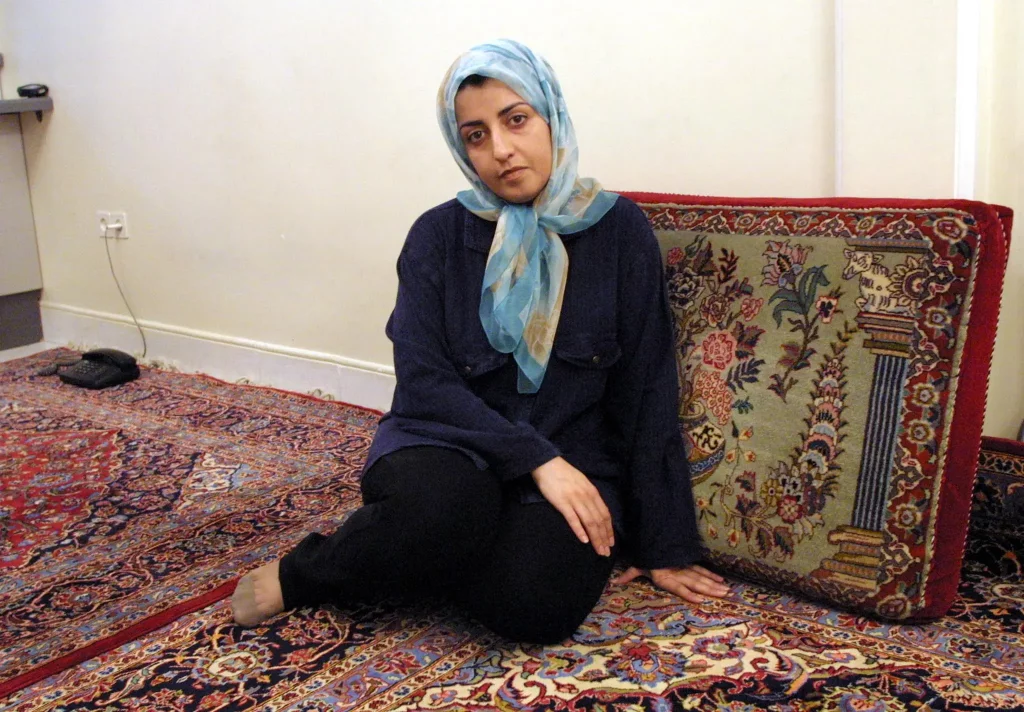
Even if the protests do not lead to the collapse of the regime, the current cries for “Woman, life, freedom!” may have already shifted the social and political landscape. And alliances between constituents as diverse as schoolgirls, oil workers, and Kurdish nationalists have emerged. Moreover, the demands of the movement have resonated around the world—including in the United States—where renewed restrictions on reproductive autonomy and violence against women in politics have generated a sense of common cause.
Are you able to give us any insight or indication of what life is like for women in Iran and young girls growing up in the country and how detrimental the current regime is to women’s rights?
After the 1979 revolution in Iran, Ayatollah Ruhollah Khomeini, the leader of the revolutionary forces, took hold of governmental apparatus, rulings and decrees directed specifically at women. His first legislative act was to mandate female government employees to veil. Clearly, the objective was to “remove autonomous, independent women from the public eye” and replace them with what he (and the revolutionary forces) wanted to present as the image of the newly formed Islamic Republic pious woman.
Under Iranian law, all women and girls 9 years old and older must cover their hair to abide by the country’s strict interpretation of Islamic dress code. And despite that Iranian women never stopped fighting, by 1983, no woman was able to set foot in government offices, because those who dared to challenge the rules, risked being beaten, lashed, arrested, fined, humiliated, fired from their jobs or even having acid thrown at them. Gradually, the Islamic Republic succeeded in chipping away the rights of women gained in the era before the revolution; domestic violence, child marriages, and more.
Are women’s voices now becoming a serious threat to the legitimacy of the Iranian theocracy?
Yes, despite the repressive regime, in 1999, female students protested the closure of a reformist newspaper, in 2009, they disputed the voting in the presidential elections, and in 2019-2020, they protested the increase in fuel prices. Now, young Iranian women are placing themselves as ‘agents of change’ not powerless victims, as the Western media often portrays them.
Acts of resistance using social media as a strategic tool are sustaining the momentum in the fight against repressive control over their bodies and minds. Under the Islamic Republic’s regime, organized collective action with strong leadership and networks of solidarity is challenging. Digital spaces and social media, thus, are becoming the site for transformative politics for women serving as spaces of cultural, social, and political contestation.

In 2014, when the brave journalist Masih Alinejad took a selfie without a veil in London and posted it on her Facebook page inspiring the country’s women to rise up, a new movement began. Many praised her for her courage, and this is how My Stealthy Freedom campaign began and became one of Iranian civil society’s biggest challenges to the regime yet. Within only a few years, My Stealthy Freedom page had more than a million followers.
In 2017, Masih Alinejad and some other activists from My Stealthy Freedom launched the White Wednesday Campaign, a new social media campaign where, on Wednesdays, women would wear a white headscarf, take it off in the street or in their cars, and film themselves while doing so. In 2018, another The Girls of the Revolution Street -started after a photo of a young woman, dressed in black and silently waving her white hijab on the end of a stick, went viral. But since Mahsa Amini’s death, the struggle for women’s rights started to take more radical forms. The public protests against the mandatory hijab law are impending the very foundations of the regime.
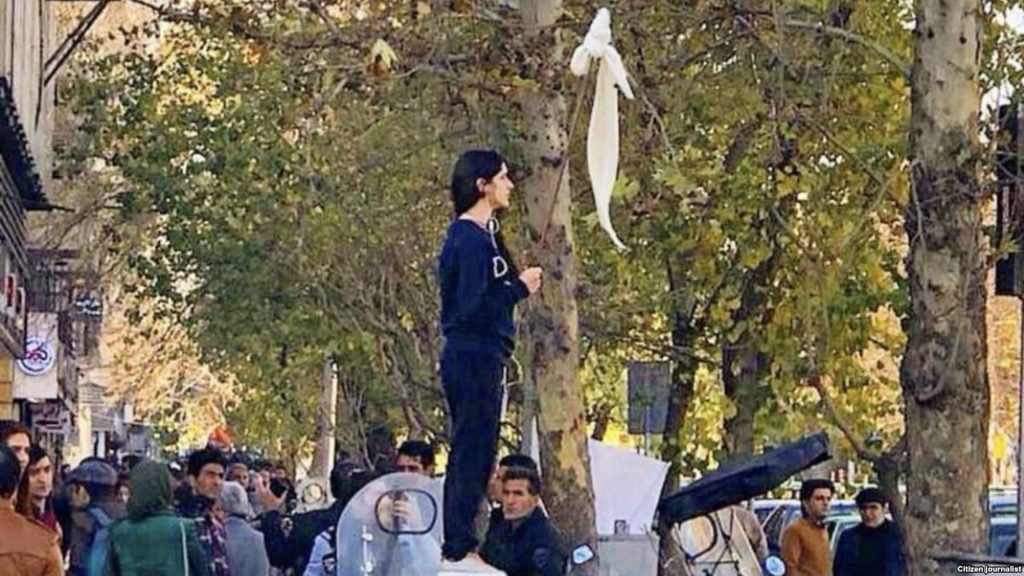
What do you believe needs to happen in Iran for women to be afforded their human rights?
I hope that this prize will send a clear message to world leaders that international pressure is needed to improve the lives of girls and women in Iran. The recognition of Mohammadi’s work has also highlighted the plight of other Iranian women and girls, including Armita Garavand, a 16-year-old who remains in a coma after being attacked by the morality police for not wearing a headscarf on a public subway car.
Over the past 44 years, Iranian women used different tactics to maintain their struggle, each phase more intense than the previous one. Through fearless public acts, Iranian women are claiming freedom of choice, freedom of expression, and freedom of religion. Now Iranian women are leading a revolutionary phase, in which Amini’s death was what triggered what I call the silent majority, those sympathetic bystanders, to fight for radical change. These are students, intellectuals, oil workers, prominent athletes, artists, merchants and more.
In the long run, women’s rights movements — if given the proper support — can triumph and lead to more open and liberal societies. As we search for effective ways to fight the global rise of authoritarianism, the key might lie in supporting women’s rights and grassroots feminist activism.
